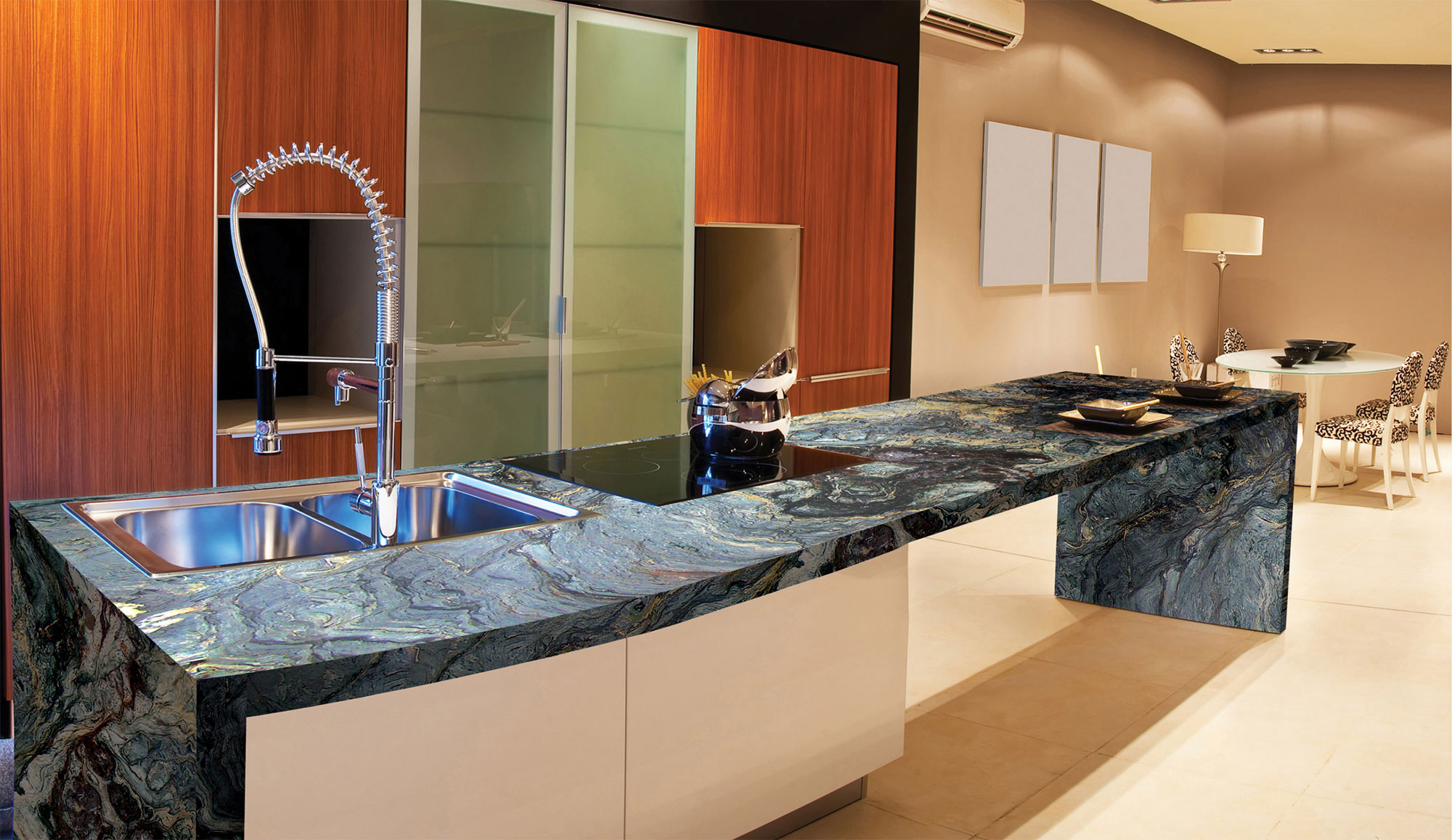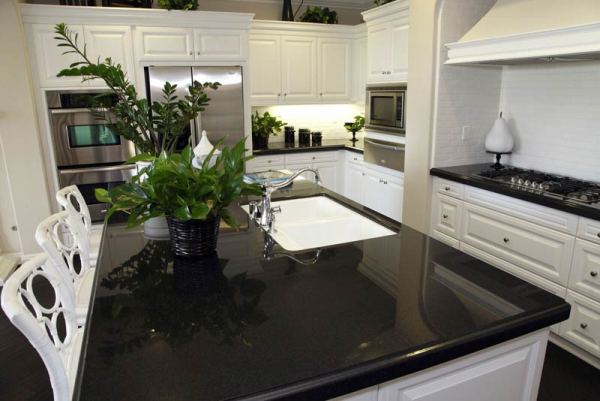
13 May How Are Granite Countertops Made?
Stunning pinks, rich greens, classy blacks. Have you ever questioned where all those granite countertops in all those incredible and astoundingly different colors originate from and how they get to your kitchen?
Granite is an igneous rock. That indicates it is volcanic in origin. Instead of draining of a volcano, granite kinds underground when magma solidifies slowly without reaching the surface area. Because it cools more gradually than appeared magma, it includes unique and noticeable crystal patterns. Differed crystal sizes occur when the rock cools at different rates; much faster-cooling yields smaller crystal sizes.
The various colors of granite are due to the differing proportions of minerals consisted of in the stone. Potassium feldspar, salt feldspar, and quartz are the primary parts of granite and yield the gray, whitish-pink, or salmon-pink granite commonly seen in structures and monoliths. Biotite adds black or brown tones; amphibole adds black or green, and muscovite includes yellow.
There is a difference between this geological meaning of granite and the commercial meaning. In the industrial sense, any difficult stone or any stone that is not marble is typically called granite. Because the meaning of granite needs that it contains 20 percent quartz, which is usually white or clear, so-called black “granite” is likely a rock called gabbro. Other igneous rocks that are typically sold as granite consist of diorite, andesite, syenite, anorthosite, basalt, and granulite. In the commercial market, gneiss and schist are metamorphic rocks that are also offered as granite.
Keep in mind that quartz countertops are a made item made of ground quartz bound together with resins.
Mining Begins at the Quarry
The manufacture of granite countertops starts with mining dimensional granite from quarries. Dimensional ways that the rock is cut in entire pieces rather than quarried for crushed stone. In the United States, granite is generally quarried in New England (New Hampshire is known as the Granite State), Texas, Indiana, Wisconsin, and Georgia, however, there are granite quarries situated in thirty-four states. However, most of this granite is utilized for constructing exteriors, floorings, and serious markers, due to the predominance of grays, pinks, and whites. The more vibrant granites are from in other places– primarily India, Brazil, and Norway.
Wire saw in stone quarry,
A wire saw in use. All stone cutting is made with the help of water as coolant and lube.
Granite is quarried in open pits. Due to the fact that granite is relatively common, deposits that are not easily accessible are not generally quarried unless the color or pattern is unique. The first step is to get rid of the overburden– the soil or gravel laying on top of the granite. Undesirable areas of stone are eliminated by drilling and blasting. At one time, granite was quarried by blasting, but now diamond wire saws are more frequently used. Vertical and horizontal holes are drilled through the stone and a wire saw is threaded through the holes.
Wire saw diamond beads
A view of diamond beads on a wire saw.
Stone Is Cut Into Blocks
The wire saw is cable television with regularly spaced diamond beads. When threaded through the holes, the cable is entwined together and mounted on a large engine that drags the wire on a constant loop through the stone while also supporting to preserve stress on the wire. These cuts with the wire saw will release a very large piece of stone– 30 to 50 feet broad and high by 6 to 9 feet deep. A soft bed of dirt is prepared and the big chunk is pushed off the cliff with wedges, airbags, excavators, or explosives. In some cases, the portion shatters or fractures at this stage, which undoubtedly is unwanted!
drilling holes in the rock
When a big area has been cut, holes are drilled to break the section into blocks.
The large portion is then divided into smaller rectangle-shaped blocks by drilling various vertical holes and inserting either explosive or expanding mortar. This produces the distinct edges seen on raw granite slabs in the storage facility.
Granite block cut by gang saw
A block of granite exits a gang saw after being cut into slabs.
A Block Becomes Slabs
The large blocks of granite are then further cut down into pieces, normally at the quarry, by giant gang saws. A gang saw has dozens of similarly spaced parallel blades or parallel wires. The blocks are filled into the saw and the whole block is cut into numerous pieces simultaneously– a process that may need 40 to 50 hours. (When cutting with diamond wire cutters, the time is substantially less.) Slabs are either 3/4 or 1 1/4 inches thick (2 or 3 cm). The pieces are typically about 9 x 6 feet (3 x 2 meters) in size. The pieces are then polished on one side, bundled together with slabs from the exact same block, filled into containers, and shipped to distributors. The pieces are bundled together to guarantee that purchasers can obtain multiple slabs that are likewise colored and patterned.

The most typical finish for granite is polished, however, honed and leathered are surfaces acquiring more appeal. The non-polished finishes are used at the fabricators. The polished finish reveals all the colors and patterns of the stone in HD, however, it also is very reflective and for that reason reveals any smudge of dirt on the surface. Developing merely eliminates the high shine from the sleek surface area. The patterns in refined granite will be silenced, and the surface area is no longer reflective. Leathering is a textured surface area developed by blasting the surface with water jets to eliminate softer locations of stone, then brushing the surface area to smooth rough edges.
Unfinished granite piece in a storage facility.
A granite piece in the warehouse.
A Piece Becomes a CounterTop
The first step in transforming substantial pieces of stone into countertops is a design conference with the customer, designer or designer, and producer. The consumer may pick to go to the storage facility and choose a slab or might leave that to the designer. Fabricators have sample squares on hand, but since granite is a natural item, numerous variations happen, even between pieces cut from the very same block.
Design template on the granite slab.
A clear design template for determining pattern layout for a section of countertop.
Fabrication begins after the cabinets are set up. Measurements are critical for a good outcome, so the location is either determined with a laser determining system, or templates are made from plywood or foam core. The measurements are then fed into a computer design program, which lays out the cuts on a piece. Some shops use high-definition photos of the slab to set out the cuts to optimize pattern matching, while others utilize clear plastic design templates to pattern-match.
Diamond wet saw cutting granite.
Diamond blade circular saws are utilized to cut slabs to size. Water functions as both coolant and lube.
The pieces are cut to the dimensions for each task utilizing a computer-controlled diamond blade damp saw or water jet. Typically, about 20 to 30 percent of a slab is discarded due to weak points in the stone or the presence of undesirable patterns. The edge treatment, if not merely squared off, is formed utilizing a router. The edge treatment is then polished or developed to match the surface area. Some fabricators cut the sink and faucet holes in the shop, while others cut those holes on-site utilizing diamond blade saws.

